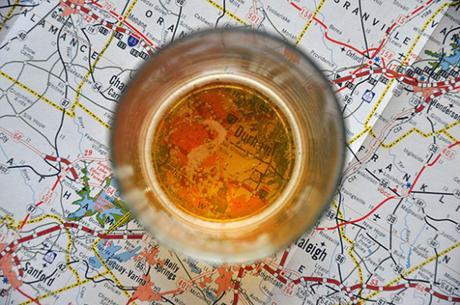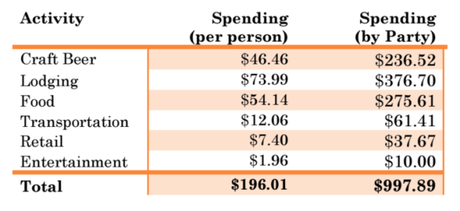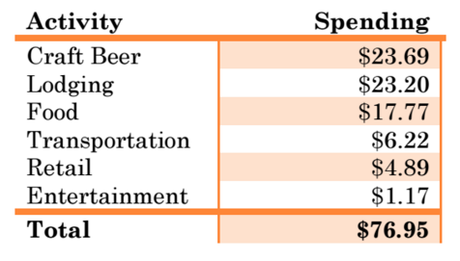
Brewery relocation has been a hot topic lately, as the American beer market looks to shrink its world.
Sierra Nevada, Oskar Blues, New Belgium, Deschutes, Stone - all high profile cases where long-tenured legacy breweries looked to the East Coast for welcoming arms, plentiful space and tax incentives, of course. Each of these businesses have added or plan to add additional facilities thousands of miles from where they originally set up shop with hope of better tapping into markets with fresher beer and more integrated associations with communities once full of strangers.
In a way, it's merely one end of a spectrum, where at the other, local rules supreme. Even if you may be a national brand, you can still find a connection to that powerful emotional theme of community.
But for as much effort as governments put into courting these companies - $18 million from North Carolina here, $5 million from Virginia there - it's important to not overlook the context of what it means to have the Big Boys of craft playing alongside your small, local startups. No matter your politics or belief in courting outside businesses, there are many reasons why this happens.
Because for whatever amount of money it may take to land one of these behemoths, at least one outcome can't be ignored. Beer isn't just a liquid in our glass, after all. Now more than ever, it's also an economic force benefiting communities around us.
In the most recent (2014) survey by Travel Portland, a tourism office for the Oregon city, results showed that 11 percent of US adults visited Portland for a leisure trip in 2013 or 2014. ( Editor's note: I realize how crazy that sounds, but I'm just taking a stat verbatim.) Among those who visited, 68 percent participated in some beer-related experience.
Alacia Lauer, regional communications and public relations manager with Travel Portland, noted that the Oregon Brewers Festival reports an estimate of more than $30 million in annual economic impact from the event.
"In 2014, they reported that 56.8 percent of attendees were from outside Oregon," she added.
In Bend, Oregon, a 2013 survey showed the most popular activities among visitors were indirectly beer related (dining, first) and or beer specific (brewery visits, third).
Similar success can be found in Kent County, Michigan, home to Grand Rapids, where research commissioned by the county showed in 2015, an estimated 42,246 visitors came to the area specifically for beer tourism, with 13,000 of those coming from outside Michigan. A third of those visitors' average daily spending was found to be on craft beer, accounting for nearly $2.2 million spent on beer alone. Total direct spending, which spans across lodging, retail, food and more, was $7 million.
For example, here's the estimated average total spending per beer tourism visit to Kent County by those staying in hotels/motels:

To emphasize beer's pull, here's another way to look at those tourism numbers, although this time it's daily spending per person, regardless of their lodging choice:

In a 2014 survey of 21 Vermont breweries, about 706,000 visitors stopped by the taprooms and production facilities, with 510,000 of those being out-of-state residents. Scale that to all breweries in Vermont at that time, and those numbers would balloon to 1.6 million total visits and 1.2 million from non-Vermont residents. Researchers working for the state brewers association estimated it amounts of an impact of $82 million.
And these are just tip of the iceberg examples.
Jeff Alworth recently wrote about the place breweries have taken among our cities, aptly titled " Breweries are the Mark of a Thriving Community." Anecdotally, I have no reason to not believe this to be true. Whether in small towns or major metropolitan cities, breweries are increasingly acting as community-building businesses, he wrote.
They are people magnets, bringing folks in who are curious to try a pint of locally made IPA. In fairly short order, breweries can create little pockets of prosperity in cities that can (and often do) radiate out into the neighborhood. Pretty soon, other businesses see the bustle and consider moving in, too.
You find this happening in places like Asheville, North Carolina, where the city's South Slope neighborhood is known as the "Brewery District," with eight such businesses already located there or planning to open. Asheville, a multi-time winner of being voted as Beer City, USA, estimates that between 2012 and 2014, 22 percent of visitors specifically sought out alcohol-related tourism while in town. Extrapolate that into about 3.3 million overnight guests Buncombe County hosted in 2015, and we're talking the potential for hundreds of thousands of people to celebrate local beer.
To put it all in perspective, Asheville breweries big and small benefit:
- Oskar Blues in nearby Brevard estimates 500,000 visitors annually.
- Wicked Weed counts the same amount - about 500,000 - visiting one of their two facilities.
- New Belgium expects around 250,000 visitors each year once open to the public this summer.
- In 2015, about 75,000 people toured Sierra Nevada's new facility in Mills River.
- Hi-Wire welcomes at least 90,000 drinkers each year.
"Asheville's reputation as a beer-focused town draws a lot of beer-focused visitors," Sierra Nevada spokesman Bill Manley told Greenville Online. "As a tourist interested in beer, there are few places in the United States that can rival the Asheville area. There is so much depth and variety in the beer scene."
That success is found all over. In Minnesota's Twin Cities area, here's the tracked economic impact for alcohol-related tourism from the Meet Minneapolis Convention & Visitors Association:
Like other areas, numbers are tracked via wine, spirits and beer. By current count, which obviously exceeds figures shared here from 2011 to 2014, there are 35 to 40 wineries and distilleries in the geographic area with 45 breweries. You can do the math and figure out the potential impact beer is having, which is leading other cities to take notice.
It was just five years ago that Maine changed a state law to allow breweries to sell beer on-site in "samples" from four ounces on up. At Portland's Rising Tide Brewery, tasting room revenue increased 50 percent last year and is projected to do the same in 2016. Heather Sanborn, co-owner of Rising Tide, noted that selling directly to visitors on-site is now "a major source of revenue and marketing for us."
"People like visiting where the beer is made, and they like having conversations with the people who made it," Bart Watson, Brewers Association chief economist told the Portland (ME) Press-Herald.
Everyone seems to be embracing the idea of beer tourism now, whether by the success of what "local" branding can create to entice consumers or through the promise of a rare and unique experience. Rochester, New York, long in the doldrums of economic troubles, is creating its own "beer trail" with signs along major interstates to showcase beer options. (New York breweries account for more than $3.5 billion in the state's economy.)
In Florida, a Tampa Bay brewery tour business a brewery because it was successful enough to make that kind of money.
With more than 4,200 breweries spread across the country, the success of these businesses should come as no surprise. From one point of view, it presents increased market competition, but from another angle, it's clear it all acts in a symbiotic way, raising all ships as one brewery is able to feed off another. Beer tourism is real and it's having real economic impacts.
All this is important to consider when we discuss things like bubbles and the future of the industry, because more than ever, it's clear everyone can play nice. This sandbox is spacious and welcoming.
So when we talk about things like subsidies and grants and all those economic buzzwords that put many people to sleep, remember that there's a tangible outcome to all of this. Beer in your glass, money in their accounts and people from all over coming to see, hear and taste what it's all about.
"Don't drink to get drunk. Drink to enjoy life." - Jack Kerouac

